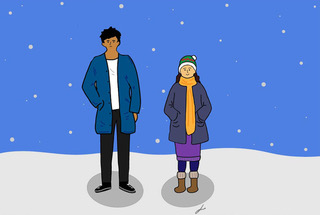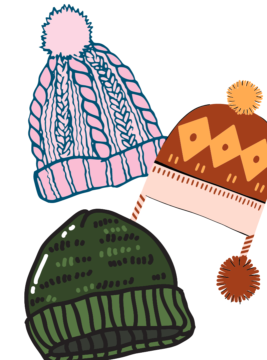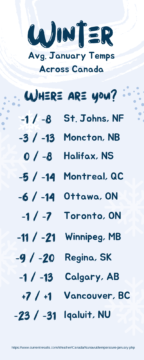There is almost nothing more Canadian than hockey, and wintertime. But at home, and abroad, people have wildly different opinions of what a Canadian winter is like. And while winter as a season is a given, exactly what winter feels like depends entirely on where in Canada you are.
For those of us living, working, and trying to play in the Greater Ottawa Area winter weather hits very differently than in the East coast, the Greater Toronto Area or the West coast. And the Prairies… don’t even get me started on winter in western Canada!
Focusing on style won't keep you warm this winter. Bundle up and stay safe. Photo credit: Sevval Kokten
Knowing how to deal with all the various levels of cold in Ottawa is the key to surviving, and dare I say enjoying, what can feel like an interminably long season. Although staying inside feels like the only way to get through the winter, for most of us that just isn’t an option.
There is so much to see and do in Ottawa, so rather than trying to avoid it, here are some top tips for getting the most out of the winter season in the Nation’s Capital.
Learn to read the weather report
Obviously know the temperature is a good starting point for understanding what is going on outside, but there are a lot of other key pieces of information that you should also pay attention to:
Severe Winter Weather Alerts – Weather alerts will be posted for conditions such as snow, rain, wind, and extreme weather. Often the alerts (also known as weather advisories) will include a timeframe for the duration of the event. A key alert to pay attention to if you are going to be walking or taking transit is extreme cold. This is issued when the daytime temperatures are extremely low, and when the wind chill is going to be a significant factor.
Hourly forecast – Weather apps will show you a snapshot of the weather at the time, but more importantly, it also gives you the forecast for the remainder of the day. If you are going to be out for several hours or planning to be out later in the day, you can get a sense of what to expect and plan your activities and clothing.
Conditions – Whether you can expect clear skies and sunshine, versus cloudy skies and snowfall are important conditions to consider when preparing to head outside. Staying dry is a key component to staying warm, so if heavy snow is in the forecast you may want to bring an extra hat and mittens.
Choose your winter gear and garb carefully
Let’s be honest, fashion is not always functional, and this is never more accurate than when we consider dressing for winter weather in Ottawa. Choosing the right cut, as well as the proper materials, will make all of the difference to your overall comfort and safety, be it your outerwear or your footwear.
Coat cover-up – Although the puffy bomber coat may be on trend, it is likely not going to keep you warm enough when temperatures dip below –20. Canada Goose® and Nobis weren’t playing around when they launched their coat lines with the mid-thigh cut and an ample hood. Covering up as much of your body with a waterproof and windproof coat material will help you keep your body heat in, and the cold air out. Choose a coat that fits snug when you are wearing a sweater or sweatshirt, and one that offers closed cuffs at your wrists.
Boots made for walking – A cute leather bootie or casual men’s boot will look great once you get where you are going, but you will have likely lost all the feeling in your toes before you get there. Ottawa is a very walkable city, and choosing footwear that is waterproof, lined, and with a thick and grippy rubber sole will make walking safer, and infinitely more comfortable. Keeping your feet dry should be a priority.
Hats are hot – Accessorizing your outfits is important and this is a place where you can let your style shine. Luckily, chunky knits, pom poms and slouchy hats are everywhere you look these days.
Keeping your head and ears covered will help prevent heat loss, and frostbite. Photo credit: Andrea Kennedy
- Choose headgear that covers your entire head, and most importantly covers your ears. Headbands are okay, but a hat is warmer. Your ears are particularly vulnerable to cold resulting in numbness, and frostbite can happen without you even being aware of it.
- Cover up your neck with a scarf long enough to tuck the ends into your jacket and wrapped so you can pull the scarf up to cover your mouth and nose as an added barrier against the cold and wind.
- Protect your fingers by choosing mittens instead of gloves when the temperatures really dip. Mittens are much warmer because they allow the whole hand to generate and retain heat, versus separating each finger. The material of your mitts will matter, so waterproof and windproof are your best bet, but quilted or tightly woven knits work as well.
To sum up, there are some very simple steps you should follow so that you can enjoy, or at the very least cope, with the great outdoors in the Ottawa area.
DOs
Invest in key pieces like an appropriate winter coat, and winter boots
- Layer your clothing from top to bottom, with a snug fit around the neck, wrists and ankles.
- Cover as much of your skin as possible, paying close attention to cheeks, ears and fingers.
DON’Ts
- Don’t wear metal frame sunglasses or extra earrings if you can avoid it – metal in your ears, on your face, gets much colder than your skin
- Don’t get overheated. If you are taking transit or walking around inside and can’t remove your outerwear, remove your hat and mitts, loosen your scarf, open the neck of your coat to let off some steam.
- Don’t prioritize style over function during extreme cold weather events. NO one looks good with frost-bitten skin, and it can happen in mere minutes and potentially cause permanent damage.

